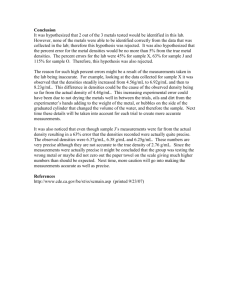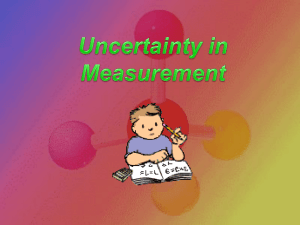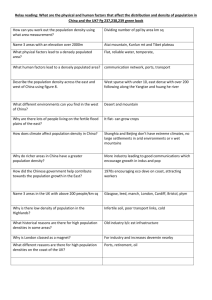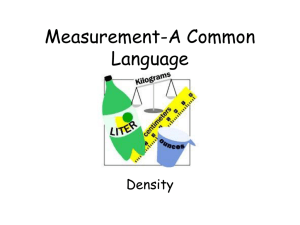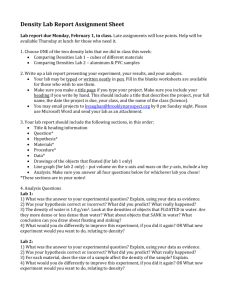Measurements!
advertisement
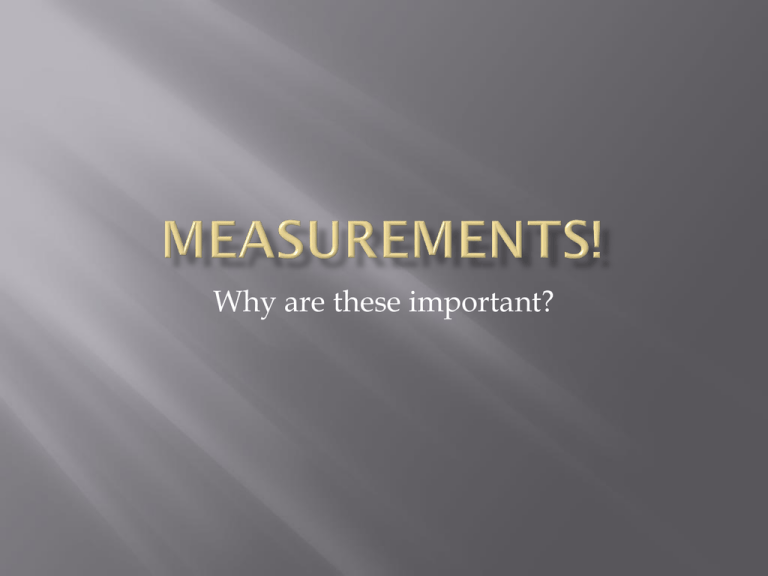
Why are these important? SI stands for Systeme International d’Unites Internationally, this is the system that we will use measure anything in science. There are several things that get measured Length, Mass, Volume/Area, Density, Time, Temperature Measured in Meters (m) How long something is or the distance between two objects Measured in grams (g) The amount of matter in an object Not the same as weight but similar Area is measured in m2 It is the amount of space on the surface something takes up. Volume is measured in the liter (L) or m3 Amout of space something takes in 3D When measuring from a graduated cylinder or a beaker, measure at the bottom of the meniscus (natural curve that water makes in a container) Amount of matter that occupies a given space Doesn’t have a special unit to itself. Labeled g/mL or g/cm3 Aka mass/volume No tool to measure Internationally time is measured by seconds (s) Usually is going to be measured by a watch or a timer In science we do no use the Fahrenheit scale. We use Celcius (C°) We could also measure in Kelvin but that’s less important at the moment Use a thermometer Unit is whatever you are measuring in. It is described as any of the SI measurements that are used Denoted with a u There are bigger and smaller units of each base units Length-meter(m) Mass- gram (g) Volume- Liter (L) Time- second (s) Temperature- Celcius (C°) Prefixes will go in front of the base unit. Prefixes are: kilo-, hecto-, deka-, deci-, centi-, milli-, micro-, nano-, picoKing Henry Doesn’t [Usually] Drink Chocolate Milk Kilo(k)- kilogram (kg), kilometer (km), kiloliter (kL), kilosecond (ks), kilounit (ku) 1ku= 1000 u (1000 of your base unit) 1u= .001 ku Hecto(h)- hectogram (hg), hectometer (hm), hectoliter (hL), hectosecond (hs), hectounit (hu) 1 hu= 100 u (100 of your base unit) 1 u= .01 hu Deka(D)- dekagram (Dg), dekameter (Dm), dekaliter (DL), dekasecond (Ds), dekaunit (Du) 1Du= 10 u (10 of your base unit) 1 u= .1 Du Deci(d)- decigram (dg), decimeter (dm), deciliter (dL), decisecond (ds), deciunit (du) 1 u= 10 du (10 du in your base unit) 1du = .1u Centi (c)- centigram (cg), centimeter (cm), centiliter (cL), centisecond (cs), centiunit (cu) 1 u= 100 cu (100 cu in your base unit) 1cu= .01 u Milli (m)- milligram (mg), millimeter (mm), milliliter (mL), millisecond (ms), milliunit (mu) 1 u= 1000 mu (1000 mu in your base unit) 1 mu= .001 u Quick Review…. 1 m = ? mm 1ms= ? s 1 L = ? cL = ? mL 1 L = ? mm HINT! If you are getting bigger divide. If you are getting smaller multiply Accuracy- is a measure of how close a measurement comes to the actual value of whatever is measured. Ex. Darts land close to the bull’s-eye Precision- the measure of how close a series of measurements are to one another Ex. The darts are all very closely grouped together. (Don’t have to be near bull’s-eye) If something is precise it isn’t always accurate. The density of a certain metal is 2.45 g/mL. You measure densities of 2.01 g/mL, 1.99 g/mL and 2.03 g/mL. Accurate, precise, or both? You measure densities of 2.45 g/mL, 2.50 g/mL, and 2.47 g/mL. Accurate, precise, or both? You measure densities of 1.57 g/mL, 3.01 g/mL, and 2.45 g/mL Accepted value- The correct value based on reliable references Experimental value- The value measured in the lab Error is the difference between the experimental value and the accepted value. Error= experimental value- accepted value The density of gold is 19.30 g/mL. You do a experiment and find a density for gold of 20.50 g/mL. What is the error in your experiment? Error can be positive or negative depending on whether the experimental value is great than or less than the accepted value. Percent error is the absolute value of the error divided by the accepted value, multiplied by 100%. Percent error= error/(accepted value) x 100% Gold PE = 1.20(g/mL)/19.30(g/mL)x 100% Gold PE = 6.21% In many branches of science, some numbers are very small, while others are quite large. To convieniently express these numbers, scientists use a short hand called scientific notation. Expresses a number as a multiplier and power of 10. If the decimal point is shifted right the power of 10 is negative If the decimal point is shifted to the left, the power of 10 is positive. I’m passing out a sheet. This is my reminder to myself… Don’t laugh at me
